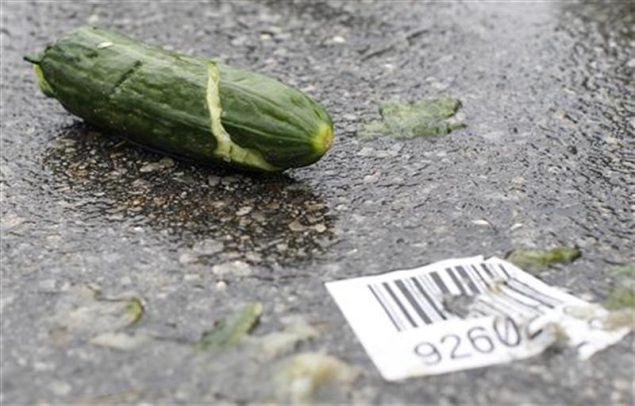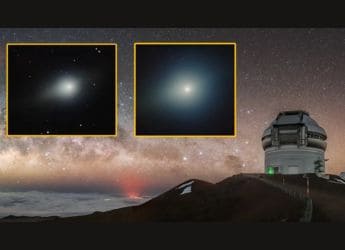- Home
- Others
- Others News
- Fight against forgery gets boost from invisible nano barcode
Fight against forgery gets boost from invisible nano barcode

Blocks of black and white Quick Response (QR) codes are increasingly common in marketing and can hold a hundred times more information than traditional barcodes. Smartphones can scan them in printed adverts to navigate to company websites.
Researchers have found out how to print them with inks that are only visible under laser light, giving them potential in the fight against fake banknotes and counterfeiting, which the OECD estimates costs the world economy more than $250 billion a year.
The invisible QR code, made by scientists at the University of South Dakota and South Dakota School of Mines and Technology, is made of tiny nanoparticles mixed into fluorescent ink, which can only be seen when illuminated with a near-infrared laser.
The process is known as 'upconversion' where the nanoparticles absorb photons at a certain wavelength and then emit them at a shorter wavelength visible in normal light.
"We can also change our parameters to make it even more difficult to counterfeit, such as controlling the intensity of the upconverting light or using inks with a higher percentage of nanoparticles," said Jeevan Meruga, who led the research.
Once lit up with the laser, the code can be scanned with a mobile phone, but the technique allows deeper levels of security with the ability to conceal information that can only be read with a microscope.
The invisible codes can still be read after paper has been folded many times and can also be printed other materials, including glass and flexible plastic film, so they could be used for a variety of products vulnerable to faking.
The research was published in the academic journal Nanotechnology.
Get your daily dose of tech news, reviews, and insights, in under 80 characters on Gadgets 360 Turbo. Connect with fellow tech lovers on our Forum. Follow us on X, Facebook, WhatsApp, Threads and Google News for instant updates. Catch all the action on our YouTube channel.
Related Stories
- Samsung Galaxy Unpacked 2025
- ChatGPT
- Redmi Note 14 Pro+
- iPhone 16
- Apple Vision Pro
- Oneplus 12
- OnePlus Nord CE 3 Lite 5G
- iPhone 13
- Xiaomi 14 Pro
- Oppo Find N3
- Tecno Spark Go (2023)
- Realme V30
- Best Phones Under 25000
- Samsung Galaxy S24 Series
- Cryptocurrency
- iQoo 12
- Samsung Galaxy S24 Ultra
- Giottus
- Samsung Galaxy Z Flip 5
- Apple 'Scary Fast'
- Housefull 5
- GoPro Hero 12 Black Review
- Invincible Season 2
- JioGlass
- HD Ready TV
- Laptop Under 50000
- Smartwatch Under 10000
- Latest Mobile Phones
- Compare Phones
- Redmi Note 15 5G
- Redmi Note 15 Pro 5G
- Redmi Note 15 Pro+ 5G
- Lava Play Max
- Poco C85 5G
- Honor Magic 8 Lite
- Jolla Phone
- Realme P4x 5G
- Asus ProArt P16
- MacBook Pro 14-inch (M5, 2025)
- OnePlus Pad Go 2
- Poco Pad M1
- Just Corseca Skywatch Pro
- Honor Watch X5
- Acerpure Nitro Z Series 100-inch QLED TV
- Samsung 43 Inch LED Ultra HD (4K) Smart TV (UA43UE81AFULXL)
- Asus ROG Ally
- Nintendo Switch Lite
- Haier 1.6 Ton 5 Star Inverter Split AC (HSU19G-MZAID5BN-INV)
- Haier 1.6 Ton 5 Star Inverter Split AC (HSU19G-MZAIM5BN-INV)
-
 Early Earth’s Deep Mantle May Have Held More Water Than Previously Believed, Study Finds
Early Earth’s Deep Mantle May Have Held More Water Than Previously Believed, Study Finds
-
 Nandamuri Balakrishna's Akhanda 2 Arrives on OTT in 2026: When, Where to Watch the Film Online?
Nandamuri Balakrishna's Akhanda 2 Arrives on OTT in 2026: When, Where to Watch the Film Online?
-
 Single Papa Now Streaming on OTT: All the Details About Kunal Khemu’s New Comedy Drama Series
Single Papa Now Streaming on OTT: All the Details About Kunal Khemu’s New Comedy Drama Series
-
 Scientists Study Ancient Interstellar Comet 3I/ATLAS, Seeking Clues to Early Star System Formation
Scientists Study Ancient Interstellar Comet 3I/ATLAS, Seeking Clues to Early Star System Formation












